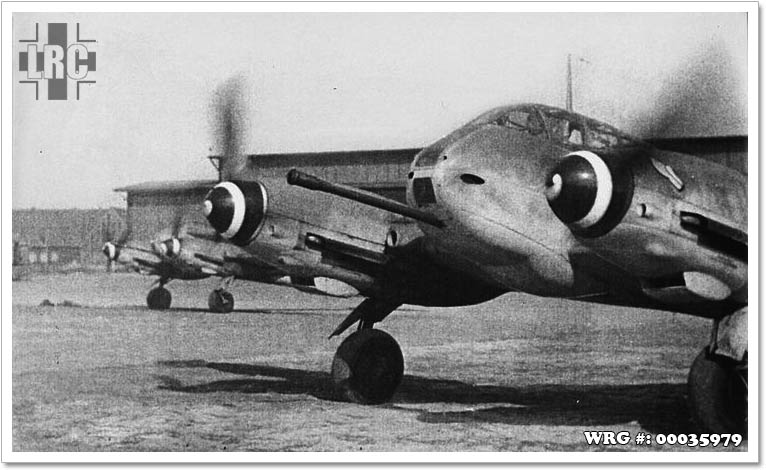Messerschmitt Me 410
The basic A-series aircraft were armed with two 7.92 mm MG 17 machine guns and two 20 mm MG 151/20 cannons in the nose and delivered as the Me 410 A-1 light bomber. Me 410A-2:
A planned Me 410 A-2 heavy fighter was cancelled because the dual 30 mm MK 103 cannon mount, was not ready in time. Me 410A-3:
A dedicated reconnaissance version, the Me 410 A-3 received a deeper fuselage for additional cameras and fuel. The Me 410 A-3 entered service in small numbers in early 1944, and equipped three long-range reconnaissance Aufklärungsstaffel reconnaissance squadrons, usually assembled with other recon squadrons as parts of larger, three or four-squadron Fernaufklärungsgruppen (one Gruppe on the Western Front and the other two on the Eastern Front). Factory conversion kits:
The Me 410A featured a bomb bay for carrying air-to-ground ordnance or for the installation of additional air-to-air weaponry or other equipment. Initially, three Umrüst-Bausätze (factory conversion kits) were available, U1 contained a palette of cameras for the photo-reconnaissance role, U2 two 20 mm MG 151/20 cannon with 250 rpg for the heavy fighter use, and U4 used the 50 mm Bordkanone series weapon, the BK-5 cannon with 22 rounds (21 rounds to load and 1 extra round already loaded into the cannon), to turn either an Me 410A or B-series aircraft into a dedicated bomber destroyer. The BK 5 cannon - derived from the Panzer III tank's main armament, the 50 mm KwK 39 L/60 - allowed the Me 410s to shoot at their targets from over 914 m (1,000 yd), a distance at which the bombers' defensive armament, usually consisting of the "light-barrel", .50 calibre AN/M2 aviation version of the M2 Browning machine guns, was useless. Frequent problems with jamming and limited ammunition supply, together with the extra 540 kg (1,200 lb) weight of the large-calibre gun under the nose, made the other anti-bomber versions of Me 410, especially those with extra 20 mm MG 151/20s, much more useful.

Messerschmitt Me 410 with 50 mm Bordkanone BK-5
[Source: Unknown]
The Me 410B-series was largely the same as the A-series, but replaced the pair of 7.92 mm MG 17s with a pair of the harder-hitting 13 mm MG 131 machine guns. The originally planned 1,900 hp (1,400 kW) DB 603G engine had been cancelled in early 1944, so all Me 410Bs used DB 603A or DB 603AA engines. The DB 603G would have increased the maximum speed to 630 km/h (392 mph), and cruising speed to 595 km/h (370 mph), although the weights increased once again. The versions were the same as with the A-series, the Me 410 B-1, and Me 410 B-3 filling the same roles as the earlier A-1, and A-3 versions, also with the options of using the same Umrüst-Bausätze factory conversion kits as the A-series aircraft used. Several experimental models were also developed. The Me 410 B-5 added shackles under the fuselage to carry a torpedo, and removed the MG 131s in the nose to make room for the FuG 200 Hohentwiel 550 MHz UHF-band maritime patrol radar. The bomb bay was not used in this version in order to make room for a 650 L (170 US gal) fuel tank, and the rearward-firing remote turrets were replaced by another 700 L (180 US gal) fuel tank for long-range missions. The Me 410 B-6 was a similar anti-shipping conversion, but intended for the short-range coastal defence role only. For this mission, it did not use a torpedo, and was instead a simple modification of the B-1 with the FuG 200 radar. The Me 410 B-7/B-8 were updated B-3 reconnaissance models that were only built as prototypes. Me 410C:
The Me 410C was a high-altitude version drawn up in early 1944, with two new wing designs that increased span to 18.25 m (60 ft) or 20.45 m (67 ft). The larger wings allowed the gear to retract directly to the rear. A new universal engine mount would allow for the use of any of the DB 603JZ or BMW 801J turbocharged engines or the Jumo 213E two-stage mechanically supercharged engines, driving a new four-blade propeller with very wide blades. The BMW 801 radials were air-cooled and the DB 603 and Jumo 213 used an annular radiator, all housed as unitized Kraftei (power-egg) engine "modules" onto an airframe for ease of installation and field maintenance, so the normal under-wing radiators were removed. None were ever built, as Me 410 production was canceled before the engines matured. Me 410D:
The Me 410D was a simpler upgrade to the B-series to improve altitude performance, but not to the same degree as the C-series. It would be powered by the DB 603JZ engines, and had a revised forward fuselage to increase the field of view of the pilot and reduce drag. It also replaced portions of the outer wing panels with ones made of wood to conserve strategic materials. Several were built, but like many other attempts at wood construction by the German aviation industry late in World War II, the loss of the Goldschmitt Tego film factory in Wuppertal, in a Royal Air Force nighttime bombing raid, meant the acidic replacement adhesives available were too corrosive to the materials being bonded, and the wooden portions tended to fail. Production was eventually cancelled to concentrate on Bf 109Gs in August 1944, after 1,160 Me 410s had been built, the month after the Jägernotprogramm had gone into effect.
Sources:
Gunston, Bill & Wood, Tony - Hitler's Luftwaffe , 1977, Salamander
Books Ltd., London
, 1977, Salamander
Books Ltd., London
Wikipedia - Me 410
Gunston, Bill & Wood, Tony - Hitler's Luftwaffe
Wikipedia - Me 410






